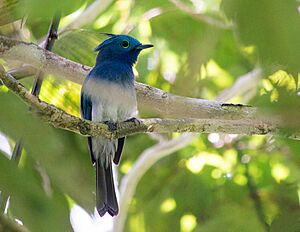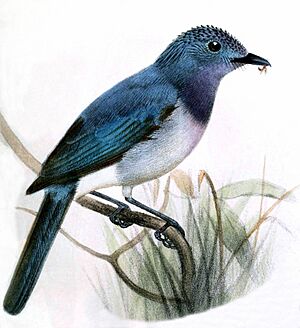Celestial monarch facts for kids
Quick facts for kids Celestial monarch |
|
|---|---|
 |
|
| Male seen in Bislig, Surigao del Sur. Photo by Adri Constantino of Birding Philippines. | |
 |
|
| Female lithograph by Smit. Yellow eye-ring and crest not drawn in. | |
| Conservation status | |
| Scientific classification | |
| Genus: |
Hypothymis
|
| Species: |
coelestis
|
| Subspecies | |
|
See text |
|
The celestial monarch (Hypothymis coelestis) is a beautiful bird known for its bright blue feathers. It has a cool blue crest on its head and a greenish-yellow patch called a wattle. This bird lives only in the Philippines. You can find it on islands like Luzon, Samar, Mindanao, Tawi-Tawi, and Basilan. Sadly, it might have disappeared from Negros and Sibuyan Island.
It often hangs out with other birds in the forest. These include blue fantails and other small forest birds. The celestial monarch lives in warm, wet forests close to the ground, usually below 750 meters (about 2,460 feet) high. Many birdwatchers from around the world hope to see this special bird.
Contents
What Does the Celestial Monarch Look Like?
The celestial monarch is a fairly small bird with a long tail. It has turquoise wings and tail feathers. Its chest and neck are a deep indigo blue, and its belly is white. The top of its head and its crest are a lighter blue.
Differences Between Males and Females
Male and female celestial monarchs look a bit different. This is called sexual dimorphism.
- Males have much longer crests.
- Males also have brighter, more intense blue colors.
- Females have shorter crests and less bright blue colors. They are generally a bit smaller.
Males are known to raise their crests when they feel excited or threatened. This often happens when they hear other males or sense danger.
What Do They Eat?
The celestial monarch mainly eats insects.
Other Names
Sometimes, people call the celestial monarch the celestial blue monarch.
Different Types of Celestial Monarchs
There are two main types, or subspecies, of the celestial monarch:
- H. c. coelestis - This type is found on Luzon, Samar, Dinagat, Mindanao, Basilan, and Tawi-Tawi.
- H. c. rabori - This type is found on Sibuyan and Negros. Sadly, this subspecies has not been seen on Negros since 1959. It hasn't been recorded on Sibuyan since the 1990s. This means it might now be extinct.
Where Do Celestial Monarchs Live and How Are They Doing?
Celestial monarchs live in tropical lowland forests. These are forests that are warm and wet, and not very high up. They are often found near rivers, especially in places that have a dry season. You can often spot them high up in the canopy (the top layer of trees).
Conservation Status
The International Union for Conservation of Nature (IUCN) has listed this bird as vulnerable. This means it faces a high risk of extinction in the wild. Experts believe there are only about 1,000 to 2,499 adult birds left. Their numbers continue to drop because their homes are disappearing.
Threats to Their Habitat
Lowland forests in the Philippines are very threatened. People cut down trees for valuable wood. They also clear land by burning it, a practice called kaingin, to make farms. This destroys the birds' homes.
The celestial monarch is now very rare in Luzon. Most sightings are now in Mindanao and Samar. A lot of records from Mindanao come from Bislig, Surigao del Sur. This area has seen a lot of forest destruction. After a logging company closed in 2005, illegal logging increased. Forests were turned into farms with only one type of plant, which cannot support these birds.
This beautiful insect-eating bird is quickly disappearing. Recent surveys show it's only found in about 10 places. Many local groups of these birds have already vanished from where they used to live. The type found in West Visayas, rabori, is now feared to be extinct. The widespread loss of their lowland forest homes means the remaining bird groups are very spread out. The Philippine Red List even calls the celestial monarch critically endangered.
Protected Areas
The celestial monarch has been seen in protected areas like the Northern Sierra Madre Natural Park and Samar Island Natural Park. There are also plans to protect more areas on Tawi-Tawi and Dinagat Islands. However, these "protected" areas often face challenges. Illegal logging and turning forest land into farms still happen. As of 2021, there are no specific plans just for saving the celestial monarch.


